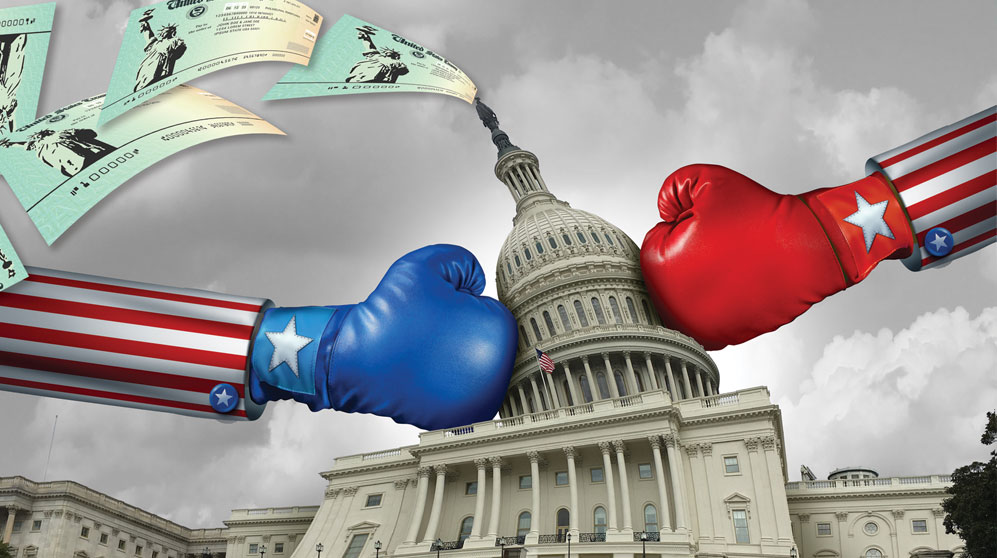A Dangerous Game of Debt-ceiling Chicken
• 4 min read
- Brief: Global Economy

Get the latest in Research & Insights
Sign up to receive a weekly email summary of new articles posted to AMG Research & Insights.

On Jan. 19, the total debt issued by the U.S. Treasury Department and held by the public or in government accounts reached its statutory debt limit of $31.4 trillion (aka, the debt ceiling).
Since then, the Treasury has been prohibited from issuing debt that would add to the total. So, it has no ability to borrow under its usual operating protocols, except to replace debt as it matures. This creates an obvious problem as the federal government’s cash outflows exceed its inflows.
Debt held by the public results primarily from the Treasury’s need to fund operating cash outflows that can’t be met by federal government revenues. This accounts for about three-fourths of the debt subject to the limit. Debt held by government accounts is that issued to the government’s trust funds and other federal accounts because of internal transactions. That debt totals about one-fourth of debt subject to the limit. Trust funds for Social Security, government retirement programs and Medicare hold most of such debt.
To keep the government operating since Jan. 19, the Treasury has engaged in certain “extraordinary measures” to avoid breaching the debt ceiling. These measures involve withholding contributions and interest payments to various government retirement plans and replacing Treasury securities held in government accounts with forms of obligations not subject to the debt limit. The Treasury can also run down its cash balance (nearly $570 billion at the beginning of February) to fund government outflows.
Currently, competing political agendas stand in the way of raising the debt ceiling. Republican leadership in the House of Representatives insists that any debt-ceiling increase must be accompanied by constraints on federal spending. President Biden and Democratic leadership in the Senate insist on a “clean” debt-limit increase without consideration of other fiscal matters.
So far, neither side has shown any willingness to change its position, hoping the other side will blink first.
The size and timing of cash flows into and out of the Treasury are uncertain. However, government and private estimates suggest that the usefulness of extraordinary measures and cash balances will expire sometime this summer, perhaps as early as June. So, absent congressional action and White House concurrence to raise the debt limit, at some point soon the government will be unable to pay all its required debt service, meet all its other legal obligations, and maintain anything close to normal operations.
It isn’t really clear what will happen in that situation. It is probable that the U.S. government would default on its debt obligations. Even if only for a short period, this would likely send both U.S. and global financial markets into a tailspin. U.S. debt would be downgraded, interest costs to the Treasury Department would jump, and the advantage of the United States due to the reserve currency status of the dollar would be undermined, as the rest of the world searches more aggressively for an alternative.
In the debt-ceiling battle of 2011 the effectiveness of extraordinary measures was nearly depleted, and the Treasury came close to running out of funds. U.S. equity values plunged about 15% while global equities were down about twice as much. U.S. Treasury securities suffered a reduction in their debt ratings.
That was a close call. One can only imagine the damage that could result from an actual event in which the government is unable to fully pay not only debt obligations, but also government contracts, employee wages, and social welfare benefits. That nightmare scenario is why an increase to the debt ceiling is a near certainty. Politicians would not want to risk taking the blame for what could happen in the alternative … or would they?
HOW AMG CAN HELP
Not a client? Find out more about AMG’s Personal Financial Management (PFM) or to book a free consultation call 303-486-1475 or email us the best day and time to reach you.
This information is for general information use only. It is not tailored to any specific situation, is not intended to be investment, tax, financial, legal, or other advice and should not be relied on as such. AMG’s opinions are subject to change without notice, and this report may not be updated to reflect changes in opinion. Forecasts, estimates, and certain other information contained herein are based on proprietary research and should not be considered investment advice or a recommendation to buy, sell or hold any particular security, strategy, or investment product.
Get the latest in Research & Insights
Sign up to receive a weekly email summary of new articles posted to AMG Research & Insights.


